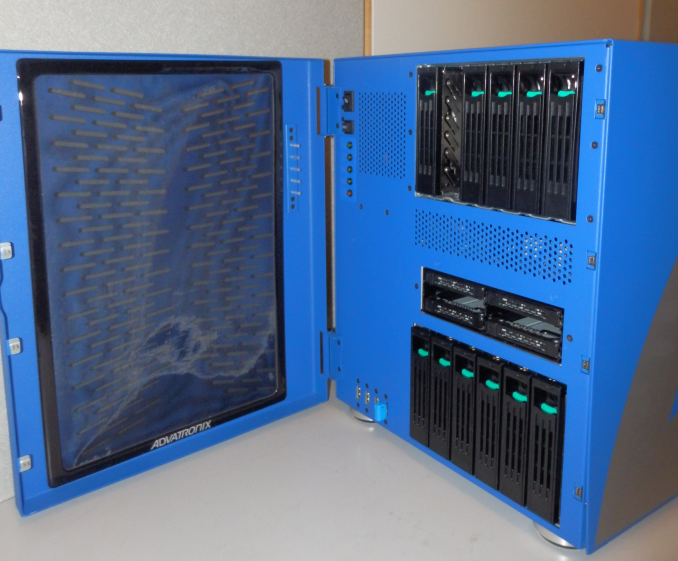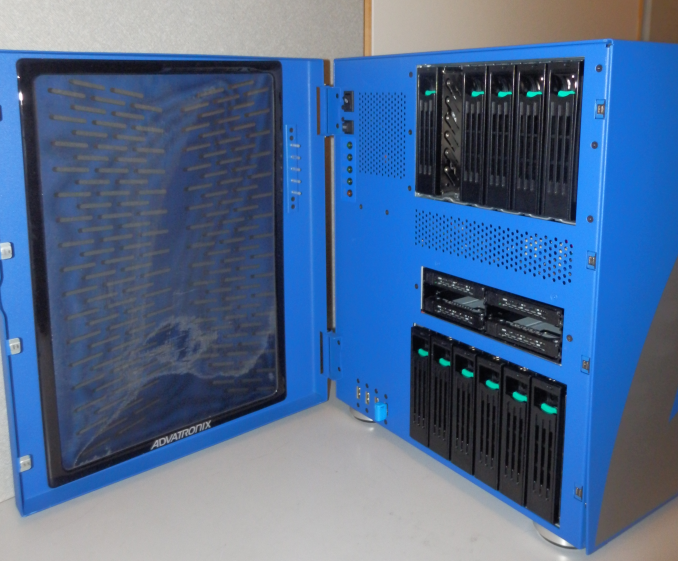Advatronix Cirrus 1200: a Storage Server Under Your Desk
by Johan De Gelas on June 6, 2014 5:00 AM EST
Almost every small company out there needs a minimum level of IT services: file serving, document management, e-mail, and so on. Most of those services can now be found in the Cloud: Google Apps Professional, Microsoft Office 365, Dropbox, Amazon AWS, and many others can take care of nearly any IT service you can think off. Although trendy, cloud services are not without disadvantages.
One example related to our review today is that the latency involved in accessing data over the internet is much higher than on a LAN. While network latency of a well configured LAN is less than half a millisecond, the latency of accessing a cloud service is several tens of milliseconds. And although high bandwidth Internet access has become a lot cheaper over the years, a 100 mbit/s or better is still not widespread among smaller companies, where a 1Gbps LAN is easily attainable. Moreover, while renting a few Terrabytes in the cloud has become relatively affordable, you again run into speed issues, especially if you have massive amounts of data that you want to analyze -- or if you simply feel that a third party should have no control over your (sensitive) data.
So if you require high bandwidth file serving and low latency database access, or if you need massive amounts of storage capacity, a local server could still be the attractive option. Of course, as a small company you likely don't have nor want a dedicated data center (or even just a smaller data room). A decent data room can be an expensive investment (e.g. it would need CRAC and other facilities) and the energy cost can be very high. Due to the costs, some might be tempted to use what others would consider an old fashioned twentieth century option: a server somewhere on a shelf or under a desk. But there are some 21st century requirements that are needed, so a noisy, power hungry tower server is out of the question. Density isn't generally an issue, but it would be great if the server is able to cool it's components in an office environment without being louder than the ambient office noise -- local whirlwinds are generally frowned upon.
The desire for a quiet, low energy server underneath your desk can still make sense: you are in control of your data, the capex investment is limited, and with a little help from a good service provider, it is workable even for those who don’t have an IT department. Sometimes, old and tried methods beat the newest hype. Advatronix felt that it could do better than the current tower server offerings and designed a proprietary chassis that resembles a cube shaped desktop.
The reason behind this rather bulky chassis with 18 (!) drivebays is that most companies that need an in-house server usually have high storage demands: they need low latency, high capacity, or both. Thus there must be enough room for plenty of magnetic disks and some space for an SSD caching tier. And of course, a large chassis also allows large fans and thus relatively quiet operation. In a nutshell, Advatronix feels the Cirrus 1200 sets itself apart from the competition for the following reasons:
- Quiet (enough) operation
- Low Power, able to keep to cool in an office environment (no need for a CRAC)
- Magnetic filter to cope with the fact that this server will be in dusty office instead of a clean data center
- A good mix of components with a focus on storage performance
As the IT services of small companies are typically bottlenecked by storage and not by CPU performance, the Cirrus 1200 uses a low power quad-core Xeon E3 with up to 32GB of RAM. It's certainly nothing earth shattering, but the combination of all points mentioned above might make the Cirrrus 1200 very attractive for a certain market niche.











39 Comments
View All Comments
JohanAnandtech - Sunday, June 8, 2014 - link
The last point is where you make a reasoning error. Most enterprises just do not want to build their own fileserver, otherwise there would be not NAS market.sciencegey - Monday, June 9, 2014 - link
I was using the last point as an example of what a SOHO could do, which this storage server is targeted at.tential - Saturday, June 7, 2014 - link
Why couldn't they just sell the case by itself.....I don't need a 4500 system, I need a decent case like that.
Aikouka - Monday, June 9, 2014 - link
Yeah, I was hoping this was actually just a server case review. =(AdvatronixSystems - Saturday, September 27, 2014 - link
We do sell the case by itself! :)Please contact sales@advatronix.com if you're interested.
watersb - Sunday, June 8, 2014 - link
Thanks for reviewing this. Very interested in storage servers. But at these price points, I'm still in "build-your-own" territory.YouInspireMe - Sunday, June 8, 2014 - link
I have truly enjoy reading and have learned so much observing the high level exchange of knowledge here on this site I wonder if you could offer a little insight to a less knowledgeable fan of this sight. Other than it being headless and having lower power consumption what are the advantages/differences between a standard server and dedicated PC with sharing on a local network.JohanAnandtech - Monday, June 9, 2014 - link
Thanks. Another advantage is the build-in BMC which allows you to do remote management (remote power on, remote console). The rest is rather obvious: very little time is needed to replace PSU and the disks. I would definitely like the latter in my desktop :-).CalaverasGrande - Monday, June 9, 2014 - link
this looks like a server from the 90's except with a powder coat finish! So it must be good?RoboKaren - Wednesday, June 11, 2014 - link
Why not look at the BackBlaze StoragePod 4.0 derived commercial product, the Storinator: http://www.45drives.com/products/If I had $5k to spend on storage, I'd give it a serious look.